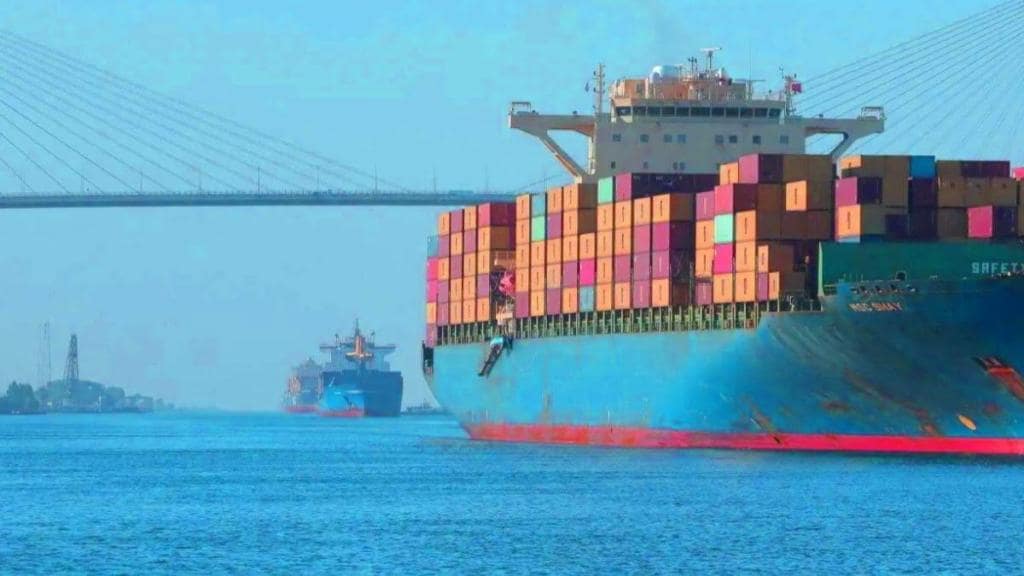By Sanjeev Sanyal, Aakanksha Arora & Nisha Verma
India aspires to increase its share in global value chains and an efficient logistics sector is key to this ambition. Approximately 95% of India’s export of merchandise trade by volume and 70% by value is done through maritime transportation. Hence, performance of seaports has a significant bearing on the country’s competitiveness.
Several measures have been implemented to improve the performance of ports in recent years through initiatives such as Sagarmala, Bharatmala, PM Gati Shakti, and National Logistics Policy 2022 to reduce the cost of logistics and improve performance. Additionally, various process reforms have been done, such as transitioning to a paperless system for various clearances at ports, implementing faceless assessment by the customs department, introducing provisions for e-way bills etc.
The impact of these initiatives is visible in port efficiency. Turnaround time, the most commonly used indicator for port efficiency, has seen significant improvement. Over the past decade, the average turnaround time for the major ports has decreased by about 50%. The average turnaround time for Indian ports declines from 4.3 days in 2012-13 to 2.1 days in 2022-23. This remarkable progress is also reflected in India’s improved ranking in the World Bank’s Logistics Performance Index.
This is no doubt a notable improvement. But we still need to do more to catch up with our global peers. According to UNCTAD, the global median ship turnaround time was 1.04 days in 2022. Norway had a median turnaround time of 0.4 days, Netherlands of 0.6 days, and Singapore of 0.8 days.
Though all ports have seen reductions in turnaround time, the all India average number masks the wide variation across ports. In 2022, among the major ports, Jawaharlal Nehru Port had the lowest turnaround time of 1.2 days, followed by Cochin Port with 1.4 days, New Mangalore Port with 1.8 days, Kamarajar and Paradip port with 1.9 days. In contrast, Deendayal Port, Vishakhapatnam Port, and Mumbai Port, jointly managing 35% of the cargo handled by major ports, registered relatively longer turnaround times of 3.2 days, 3 days, and 2.8 days, respectively. This is not to say that these ports haven’t seen reduction in turnaround times. In 2012-13, the respective figures for these ports were 6.3 days, 5.4 days, and 5.6 days.
Another metric to evaluate the overall efficiency of the international trade cargo clearance process is the average release time. This metric includes the end-to-end duration from the arrival to the departure of cargo from the port, encompassing all processes such as custom clearance, other regulatory clearances, dwell time and logistics. The Central Board of Indirect Taxes and Customs has been providing data on this parameter through the National Time Release Survey since the past three years.
The average release time for exports declined by 6.5% in last two years, from 7.8 days in 2021 to 7.3 days in 2023. Notably, within the 7.3 days, only 0.8 days on average, was needed for getting the customs clearance. The remaining 6.5 days, which is close to 90% of total time taken, was needed after getting the customs clearance. This indicates that, though the customs clearance happens really quickly for exports, it still takes an inordinate amount of time for the final departure of goods.
Despite the fact that the customs process is now taking little time on average, why is there is still a long linger time at the seaport? The reason for this needed closer examination. One part of it is that the other processes at the seaports such as entry of the trucks at terminal premises, security clearances, loading of the cargo into vessels, etc. still take an inordinate amount of time. This needs attention.
However, our analysis suggests that another important reason for the high linger time on ports is related to the high standard deviation in time taken for processes. The uncertainty about the time taken for the clearances and processes means that exporters and importers build in buffer times, which creates a longer linger time. Since the exporters intend to minimise the risk of missing the delivery time, the proclivity to err on the side of caution is more pronounced. This is costly both in time and money terms. To be fair, the standard deviation has come down, for both exports and imports. For instance, standard deviation in average release time for exports has come down by 18% from 2022 to 2023. However, it is still very high and need to reduce further.
The efficiency of our ports is critical to our future growth. India has witnessed large improvements in the port performance. Port processes other than customs clearance need to be smoothened. Moreover, an issue that is often overlooked by a focus on averages is the problem of variation that now needs greater attention. After all, efficient logistics is not just about average speed but certainty.
Sanjeev Sanyal, Aakanksha Arora & Nisha Verma, respectively, member, joint director, and Young Professional, EAC-PM. Views are personal.


